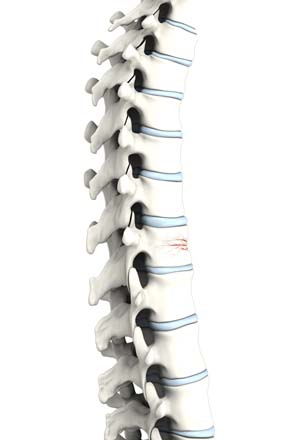Vertebroplasty

WHAT IS VERTEBROPLASTY?
Vertebroplasty is a minimally invasive procedure which is performed to reduce or eliminate pain caused by vertebral compression fractures.
INDICATIONS FOR VERTEBROPLASTY
Vertebral compression fractures usually occur due to osteoporosis, a “silent” disease characterized by weakening of bones, typically in the hip and spine, making them more susceptible to fractures. Elderly people, especially post-menopausal women, are at greater risk of developing osteoporosis-related fractures such as vertebral compression fractures.
Vertebral compression fractures can also occur due to conditions such as multiple myeloma, vertebral hemangioma, and tumors.
The weight-bearing regions of the spine are mostly affected. Many of these fractures occur by minimal trauma or no trauma at all. They can occur while doing simple activities such as bending or twisting. Symptoms range from severe pain in the back, arms, and legs to no pain at all.
Most patients suffering from such a fracture may believe that their back pain is just a part of aging, letting these vertebral compression fractures go undiagnosed. However, a single vertebral fracture significantly increases a person’s risk of further fractures. When multiple fractures occur, it causes the spine to become rounded and bent forward resulting in loss of height and a hunchback appearance. This forward curvature of the spine negatively affects the quality of life of the patient and makes it more difficult for them to breathe, eat, walk, or sleep.
Vertebroplasty involves injection of bone cement into the fractured vertebra under high pressure. This stabilizes the fracture and prevents further collapse of the vertebra, averting deformity.
PROCEDURE FOR VERTEBROPLASTY
The procedure is performed under general or local anesthesia. You will be lying face down on the operating table. Your doctor will make a very small 1/2-inch incision in the skin over the fracture site. Under live X-ray guidance, a hollow needle called a trocar is introduced through the back and is positioned within the fractured vertebra. Next, bone cement is injected into the area through the trocar under high pressure. After the vertebral body is filled completely with the bone cement, the needle is withdrawn before the cement hardens. X-rays or CT scans may be done to confirm the effective spread of the bone cement into the fractured vertebra. The skin incision is closed using steri-strips.
CONTRAINDICATIONS
The procedure cannot be performed under the following situations:
- Compression fracture is stable and does not cause any pain
- A fractured fragment or tumor is present in the spinal canal
- Presence of a bone infection or bleeding disorder
RISKS AND COMPLICATIONS
As with any surgery, some risks can occur. General complications include bleeding, infection, blood clots, and reactions to anesthesia. The specific complications following a thoracic vertebroplasty include leakage of the bone cement into surrounding soft tissues or veins and damage to the spinal cord or spinal nerves leading to numbness or paralysis.
